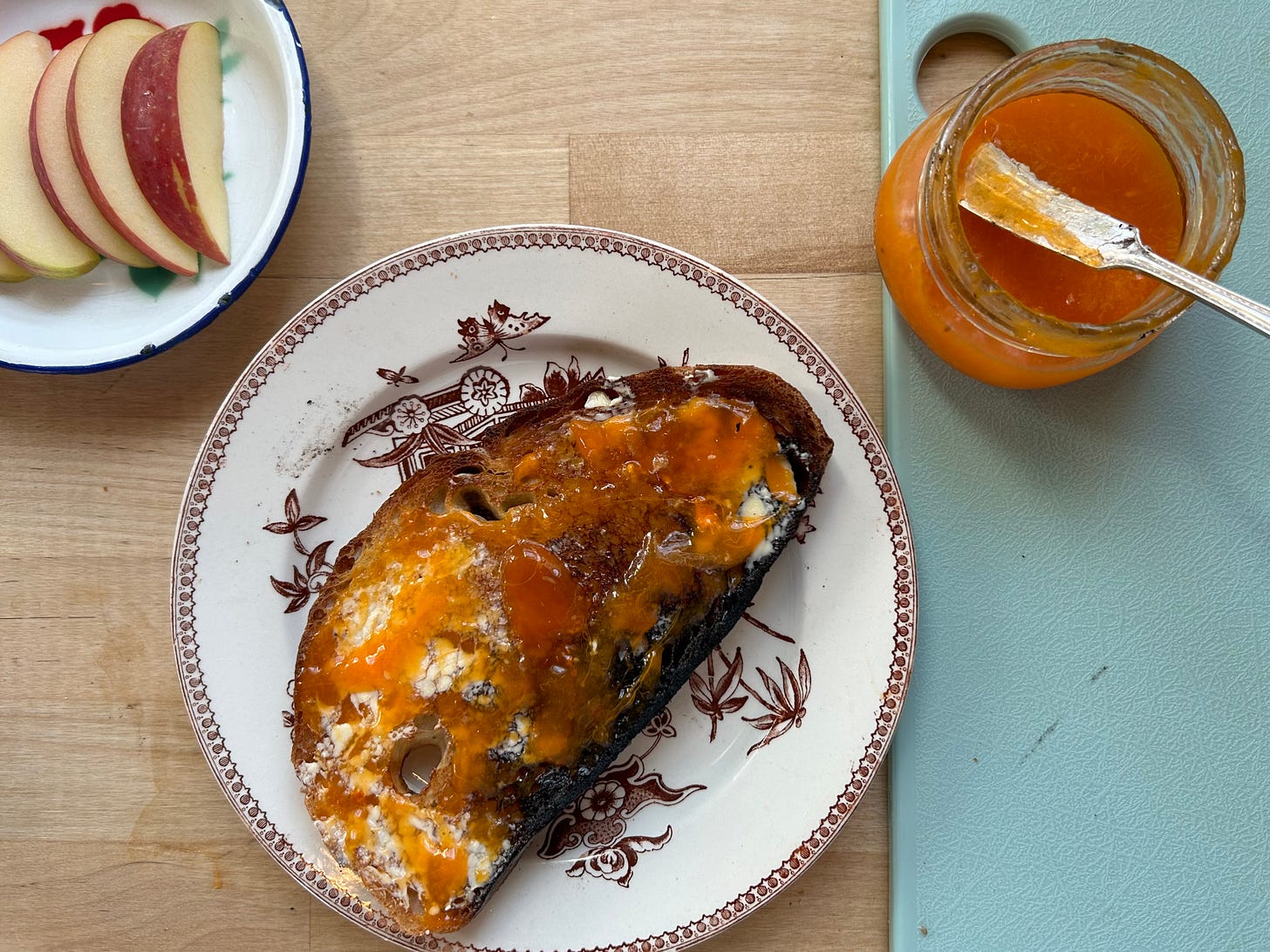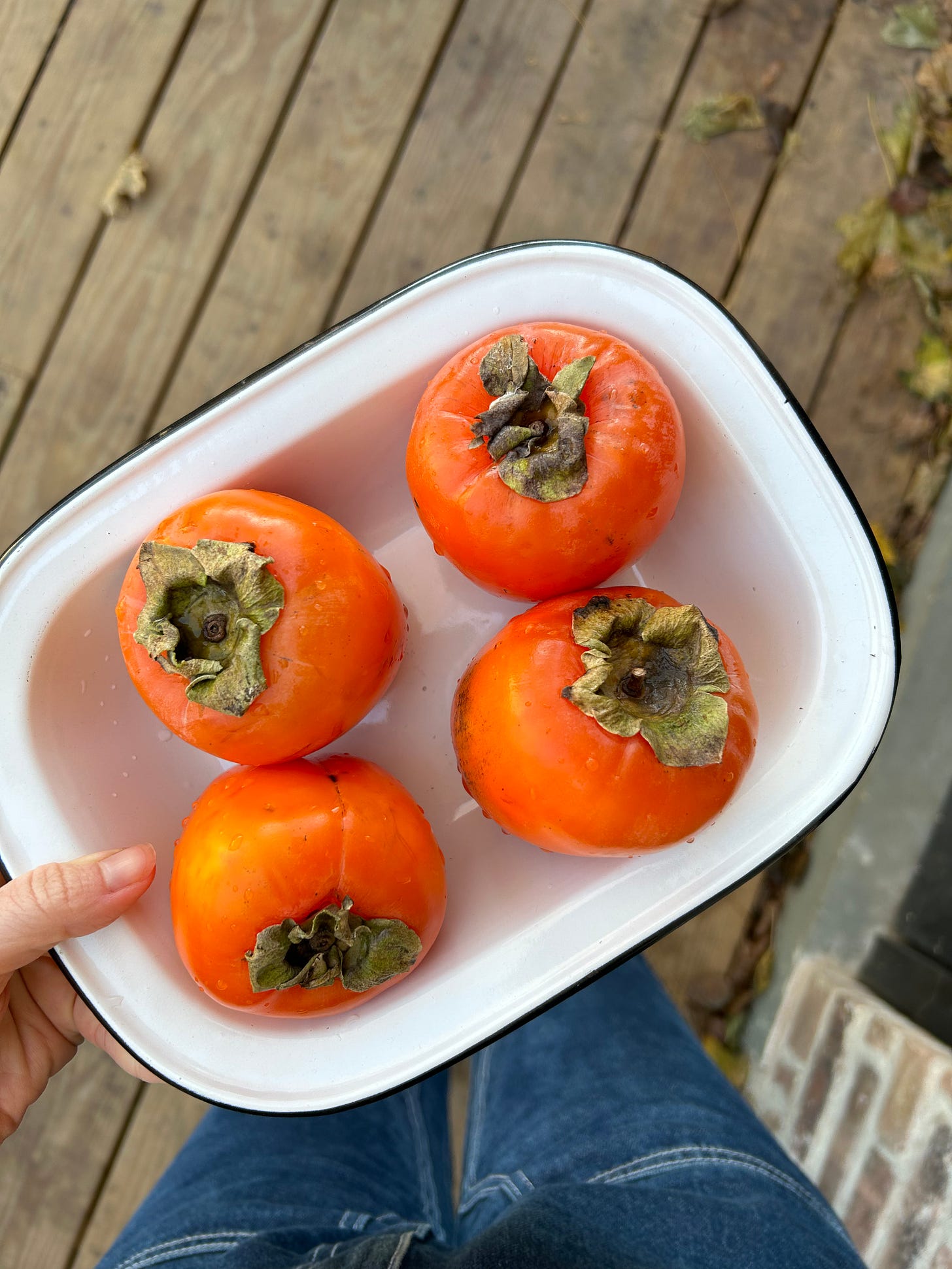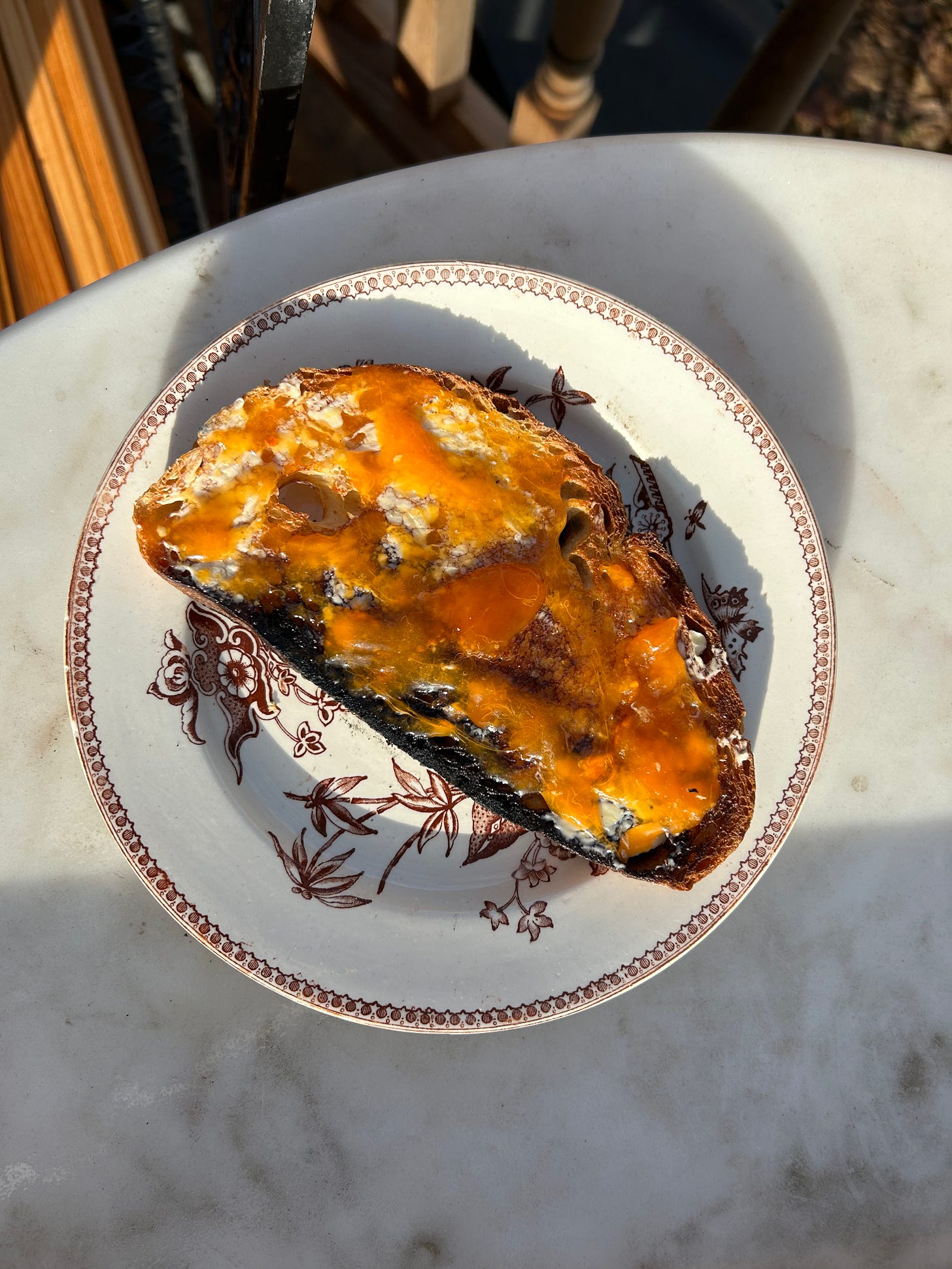Every winter Persimmons beckon to me at the grocery store with their vibrant color—a color that can only be described as: persimmon. It’s not just the color that’s singular, but the taste too. A taste that I find really hard to describe. Not tart, mostly sweet but in a way that at first you think is savory. I don’t think there is anything to compare it to. I find myself buying them, but figuring out what to do with them is another story. The texture is a challenge, especially if they’re not perfectly ripe. If I slice into them too early the flesh sits uncomfortably on my tongue, and the chew is not quite right. Even ripe they never seem soft enough to eat raw. I suspect I have always eaten them slightly under-ripe.
This time, upon spotting them at the store, I decided to try something completely different, and make jam. My inspiration came from Instagram, where one of my favorite accounts (@snarkybutdelish), posted a gorgeous breakfast of the most beautiful persimmon compote on top of a homemade biscuit and whipped cream. I could think of nothing else. I consulted my usual sources: the New York Times, Marion Cunningham, and The Flavor Bible, and using a few different jam recipes for reference, I landed upon a method that yielded a sweet, but not too sweet, jam, thanks to the juice of half a lemon to contrast that weird, uniquely persimmony sweetness, which I feared could be cloying with too much sugar added.
Casual jams and preserves are actually really easy. The challenge, I’ve discovered, is picking the right method for the fruit in question. I describe this jam as casual because I am absolutely not sterilizing jars and vacuum-sealing lids. A casual jam should keep in the fridge for up to a couple of weeks or longer. The biggest challenge here is texture, I think. The first time I tried it I pureed the fruit in a food processor, which yielded too soupy of a liquid (which I should have seen coming). I thought simmering it as I would a marmalade would thicken it, but no. There were other issues to come during that first effort, but I’ll get to that in a minute.
For my next go-around I let the persimmons sit on my counter ripening way beyond ripe. I let them get as mushy as possible. So over-ripe that the fruit practically slipped out of its skin, as you would pull your hand from a glove. I then mashed it with a fork. It’s pretty easy to go overboard here. As with many jams you want a bit of chunk, so I resisted the urge to over-do it.
Now we come to the actual jam-making. As far as I could tell from my limited research, there were two approaches that I wanted to consider, the first being maceration, by leaving the fruit raw and simply adding sugar and allowing it to sit awhile. The second: adding sugar and applying heat. Combining the fruit and sugar in a saucepan and simmering it, constantly whisking to avoid caramelizing or burning the sugars. I chose wrong the first time. I applied heat, and it was a total disaster. I cannot speak to the science behind this, but the persimmons seemed way off. Not only did their color become dull, but the flavor and texture transformed, and not in a good way. I cannot even describe the sensation I experienced upon tasting the result. It wasn’t even the taste that was bad, it was the way that it felt in my mouth and in my throat. Almost as if I was having an allergic reaction. I wondered if that was why I see persimmons applied in only a few different ways: mostly raw in salads or as a garnish, by themselves, or in an English-style pudding (as in the NYT’s Persimmon Pudding).
Fast forward a couple of weeks, and I had my mushy overripe persimmons ready to go. They were so overripe that one morning Reed stood nearby, staring down at them, asking: “so…what exactly is going on here?” I knew then it was time for my second attempt. Sidenote: I read in The Flavor Bible that you can speed up the ripening process by leaving them overnight in the freezer, but I wasn’t exactly in a rush so I didn’t try that. Maybe next time.
I slipped the fruit out of their skins, I mashed just a bit, and scattered the sugar and lemon juice over the fruit, letting it sit for 30 minutes before decanting them into jars.
That first evening I ate it on top of Greek yogurt, and then later on for dessert on top of vanilla bean ice cream, along with some sea salt to bring out the flavor. So yum, though vanilla is an overpowering taste for this fruit—the ice cream was center stage.
The next morning I spread it on top of toasted sourdough that had been buttered—a perfect snack. I also plan to try it on top of oatmeal, along with some spicy olive oil, in lieu of maple syrup. And maybe some sea salt? We’ll see. I’m not sure if I’ll get my act together but I suspect that the jam would be interesting on a puff pastry tart, perhaps with blue cheese or something. Though again that brings us to the problem of heat application. I wonder how it would turn out.
Persimmon-Lemon Jam
Ingredients:
4 overripe persimmons, peeled
1/3 c sugar
the juice of half a lemon (plus more, to taste)
Method:
Once the persimmons are as ripe as can be, slip them from their skins (or peel if they’re a bit too hard for that) and add them to a medium bowl.
Carefully mash with a fork so as not to decimate the texture of the fruit. Add the sugar and allow to dissolve. Give it a stir and add the lemon juice to taste.
Let sit for at least 30 minutes and allow the sugar and acid to macerate the fruit. Portion into jars and store in the fridge.
Possible applications:
Served atop a bowl of Greek Yogurt, along with granola and/or seeds or dried fruit
As a topping for oatmeal/porridge, along with savory olive oil and sea salt.
As a topping for vanilla ice cream
Spread onto toasted bread or English Muffins, along with lots of butter.
Misc. recommendations…while I have you…
Long Live newsletter: In each issue of this fantastic newsletter (my favorite on style), Erika Veurink spotlights an element of style, along with suggestions for how to wear it, what to buy, and how to integrate it into one’s wardrobe. She also has wonderful taste in books and is a prolific reader, so I also rely on it for book recommendations. Erika recently featured me (discussing one of my favorite items of clothing) and HCD, and it was such a pleasure (thank you again, Erika).
The Lying Life of Adults (Netflix): Nicole and I started this series from Italy (based on Elena Ferrante’s most recent novel of the same name). I love a good unreliable narrator story, and this is no exception. The cinematography, costumes, and acting are all excellent, and how can I say no to anything set in Naples?
Catbird’s delicate classic jewelry: I make this somewhat decadent recommendation because nothing makes me feel more elegant, even at my most dressed down, than my Catbird bracelets, which I never remove. I wear one on each wrist. The left side is soldered on, which they can do for you at their Soho shop. I don’t know why but I just love the idea of permanent subtle jewelry (they can of course remove it for you anytime). My friend Heather just had a charm added to hers—now I’m wondering if I need one of those.
Notable recipes round-up / Second half of December ‘22
12.10 / Trevor Joyce’s Pasta e Ceci (which I wrote about here)
12.17 / Molly Baz’s Lemony Yogurt with toasted walnuts and jammy eggs (from Cook This Book)
I loved this, but it’s actually kind of easy to screw up. I added too much garlic to the yogurt so that was pretty much all we could taste. Excited to make it again, correctly.
12.17 / Charlotte Ree’s Vanilla Basque Cheesecake
I’m incredibly excited for Charlotte’s forthcoming memoir HEARTBAKE (no word yet on a US publisher but my fingers are crossed). She told me that this recipe, which she generously shared in response to my plea in an Instagram dm, will appear in it. I love this cheesecake so much. I’ve made it five times. Newsletter on this to come.
12.17 / Alison Roman’s Matzo Ball Soup
Never in a million years would I have thought I’d make Matzo Ball Soup—something I love deeply but have always assumed should be left to the professionals. Luckily I make what Alison Roman tells me to make. I can’t say my balls turned out perfect…they were falling apart just a bit, but imagined it to be much harder than it is. Excited to give it another go.
12.18 / Molly Baz’s Breakfast Tacos with Scallion salsa and toasted pepitas (from Cook This Book)
No notes. This was so good.
12.19 / Colu Henry’s Puttanesca (from Back Pocket Pasta)
Hello old friend. Reed reminded me that we hadn’t had puttanesca in awhile. Never disappoints.
12.21 / Colu Henry’s Spaghetti with Capers & Chili Oil (from Back Pocket Pasta)
I know I said the spinach pasta was my fave from Colu’s book, but actually this one is. There was a period where I was making it monthly. There are few dishes more comforting than pantry pasta.
12.22 / Molly Baz’s Pork Sausange with celery salad and French lentils (from Cook This Book)
This dish has all of the elements for a nourishing meal. Make it if you’re feeling low energy, or just know you need something but can’t put your finger on what.
12.23 / Spaghetti alla Carbonara (from my recipe)
I made this again at my mom’s request when she was here for Christmas. This time the sauce wasn’t loose enough. Should have added more pasta water.
12.25 / Alison Roman’s Buttermilk Pancakes
A great recipe for pancakes! And a satisfying use for any buttermilk you need to use up.
12.27 / Turkey Stock & Turkey soup with russet potatoes, paprika, and thyme (from my recipe)
Made from my gorgeous Christmas turkey which I am still so proud of. I used the last of the stock in split pea soup last night.
12.28 / Turkey soup with leeks, rosemary, and farro (from my recipe)
This farro version was my preferred turkey soup of the two.








jam craving—acquired